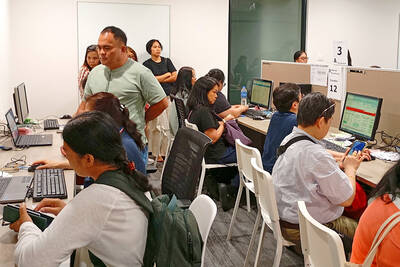The newly refurbished Route 3 that cuts through this remote town is an ordinary strip of pavement, the type of two-lane road you might find winding through the backwoods of Vermont or sunflower fields in the French provinces.
But On Leusa, 70, who lives near the road, calls it "deluxe."
As a young woman she traded opium and tiger bones along the road, then nothing more than a horse trail.

PHOTO: AFP
Yesterday, the prime ministers of Cambodia, China, Laos, Myanmar, Thailand and Vietnam inaugurated the former opium smuggling route as the final link of what they call the "north-south economic corridor," a 1,150km network of roads linking the southern Chinese city of Kunming to Bangkok.
The network, several sections of which were still unpaved as late as December, is a major milestone for China and its southern neighbors. The low-lying mountains here, the foothills of the Himalayas, served for centuries as a natural defensive boundary between Southeast Asian civilizations and the giant empire to the north. The road rarely follows a straight line as it meanders through terraced rice fields and tea plantations.
Today, those same Southeast Asian civilizations alternately crave closer integration with that empire and fear its sway as an emerging economic giant. China, in turn, covets the land, markets and natural resources of one of Asia's least developed and most pristine regions.
With trade across these borders increasing by double digits every year, China has helped construct a series of roads inside the territory of its southern neighbors. The Chinese government is paying half the cost of a bridge over the Mekong River between Laos and Thailand, due for completion in 2011.
It financed parts of Route 3 in Laos and refurbished roads in northern Myanmar, including the storied Burma Road used by the Allies in World War II to supply troops fighting the Japanese. China is also building an oil and gas pipeline from the Bay of Bengal through Myanmar to Kunming.
Taken together, these roads are breaking the isolation of the thinly inhabited upper reaches of Laos, Myanmar and Vietnam, areas that in recent decades languished because of wars, ethnic rivalries and heroin trafficking. The roads run through the heart of the Golden Triangle, the region that once produced 70 percent of the world's opium crop.
The new roads, as well as upgraded ports along the Mekong River, are changing the diets and spending habits of people on both sides of the border. China is selling fruit and green vegetables that favor temperate climates to its southern neighbors, and is buying tropical fruit, rubber, sugar cane, palm oil and seafood.
"You never used to see apples in the traditional markets," said Ruth Banomyong, an expert in logistics who teaches at Thammasat University in Bangkok.
Overall, even before the completion of the road, trade between China and the upland Southeast Asian countries Cambodia, Laos, Myanmar, Thailand and Vietnam had risen impressively, to US$53 billion last year from slightly more than US$1 billion a decade ago.

Kehinde Sanni spends his days smoothing out dents and repainting scratched bumpers in a modest autobody shop in Lagos. He has never left Nigeria, yet he speaks glowingly of Burkina Faso military leader Ibrahim Traore. “Nigeria needs someone like Ibrahim Traore of Burkina Faso. He is doing well for his country,” Sanni said. His admiration is shaped by a steady stream of viral videos, memes and social media posts — many misleading or outright false — portraying Traore as a fearless reformer who defied Western powers and reclaimed his country’s dignity. The Burkinabe strongman swept into power following a coup in September 2022

‘FRAGMENTING’: British politics have for a long time been dominated by the Labor Party and the Tories, but polls suggest that Reform now poses a significant challenge Hard-right upstarts Reform UK snatched a parliamentary seat from British Prime Minister Keir Starmer’s Labor Party yesterday in local elections that dealt a blow to the UK’s two establishment parties. Reform, led by anti-immigrant firebrand Nigel Farage, won the by-election in Runcorn and Helsby in northwest England by just six votes, as it picked up gains in other localities, including one mayoralty. The group’s strong showing continues momentum it built up at last year’s general election and appears to confirm a trend that the UK is entering an era of multi-party politics. “For the movement, for the party it’s a very, very big

A new online voting system aimed at boosting turnout among the Philippines’ millions of overseas workers ahead of Monday’s mid-term elections has been marked by confusion and fears of disenfranchisement. Thousands of overseas Filipino workers have already cast their ballots in the race dominated by a bitter feud between President Ferdinand Marcos Jr and his impeached vice president, Sara Duterte. While official turnout figures are not yet publicly available, data from the Philippine Commission on Elections (COMELEC) showed that at least 134,000 of the 1.22 million registered overseas voters have signed up for the new online system, which opened on April 13. However,

ENTERTAINMENT: Rio officials have a history of organizing massive concerts on Copacabana Beach, with Madonna’s show drawing about 1.6 million fans last year Lady Gaga on Saturday night gave a free concert in front of 2 million fans who poured onto Copacabana Beach in Rio de Janeiro for the biggest show of her career. “Tonight, we’re making history... Thank you for making history with me,” Lady Gaga told a screaming crowd. The Mother Monster, as she is known, started the show at about 10:10pm local time with her 2011 song Bloody Mary. Cries of joy rose from the tightly packed fans who sang and danced shoulder-to-shoulder on the vast stretch of sand. Concert organizers said 2.1 million people attended the show. Lady Gaga